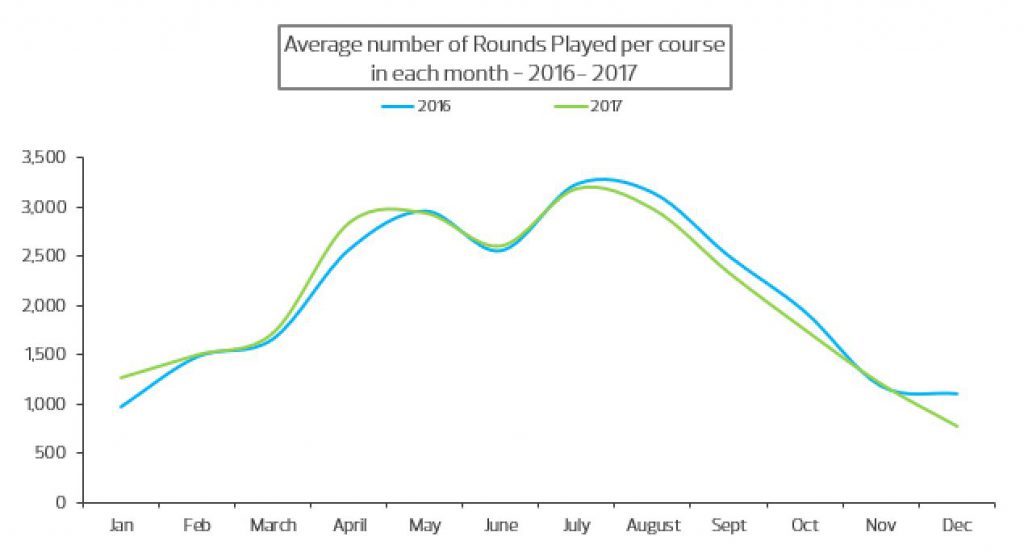Shock 11% drop in golf rounds played at end of 2017
The latest research on golf participation in the UK has found that the number of rounds played in the final quarter of 2017 was down by more than 11 per cent compared with the end of 2016.
While the figures show the industry can not be complacent about participation, the company behind the research has stressed that the results for 2016 were particularly positive, and this possible outlier may explain the large fall.
The figures also relate to October to December when golf participation is traditionally down, whereas for the first half of 2017 participation was up on the previous year. As the graph shows however, results from the second half of 2017 were significantly different.

“We can exclusively reveal that compared to the same period in 2016, rounds played were lower for quarter four across all regions, leading to an average drop of 11.4 per cent,” said a spokesman for SPORTS MARKETING SURVEYS INC. (SMS INC.)
“Q4 2016 had experienced a relatively strong period for rounds played, with the strongest October and December in the last five years both occurring in 2016.
“To some degree therefore the year on year decline over the final months of 2017 was to be expected. The drop over the final three months of the year also contributed heavily to the fact that rounds played for the full year were fractionally down nationally.
“Despite this, year end figures for Scotland, the Midlands and the south regions all showed stability or slight growth compared to 2016.”
SMS INC. director Richard Payne added: “Golf clubs across the country experienced a difficult second half of the year in terms of rounds played.

“After a relatively strong opening four months, figures from May onward were disappointing, leaving 2017 with the lowest monthly average rounds in the last five years.
“There are some positive stories around individual regions, and the challenge is to continue that trend nationwide in 2018. It is clear that the golf industry needs to work hard to find new, creative, accessible ways to encourage people to play more golf amidst ever fiercer competition for the leisure minute and the leisure pound.
“One area that golf clubs and organisations may wish to look at is how they can elongate the season to maximise months like March and October. Looking at the Q4 results, Octobers for both 2016 and 2017 have been drier and warmer than average and rounds played have stacked up well against figures from 2013 to 2015.”















Surely the simple reason why rounds played were up earlier in the year and down later was the weather.
Drier Spring, wetter Summer! Simple.
I suspect that once we’ve ruled out the obvious things to blame like slow play, fast play, lack of women and juniors etc which are unlikely to have that sort of impact in a specific 3-6 month period then Simon has nailed it. Members loyally turn up, week in, week out. The more flexible golfers don’t so if the profile is shifting towards those and the weather’s not great then clubs will be quieter. That said, was the weather any worse, other than December? Can’t stress enough the importance of finding and looking after “proper” members.
Personally I think it just shows how people are playing for enjoyment and don’t enjoy playing in poor weather. Previous generations played no matter what and you still see them. The modern flexible and pay and play golfer isn’t going to force themselves out in the less pleasant off season conditions.
After playing and working in golf for 9 years then switching to a job where I have less time I simply don’t have time to play golf. Unfortunate by speeding the game up I think you lose some of the “magic” of golf, it’s catch 22!
Would be interesting to see the stats for other forms of the game…..9 hole participation, driving range use, adventure golf, par3/ pitch put rounds.
Two words – ‘Slow Golf!’
Bad weather a factor?
It would be good to see numbers by county are these available?
We need to encourage golf clubs to work with juniors. Some of our [Whole in 1 Golf] corporate partners are private schools and when we’ve introduced them the results have been brilliant. Pro’s visiting the school, the school going to the club. Parents become involved. It’s a no brainer for clubs and we are happy to form that relationship.